Category: International
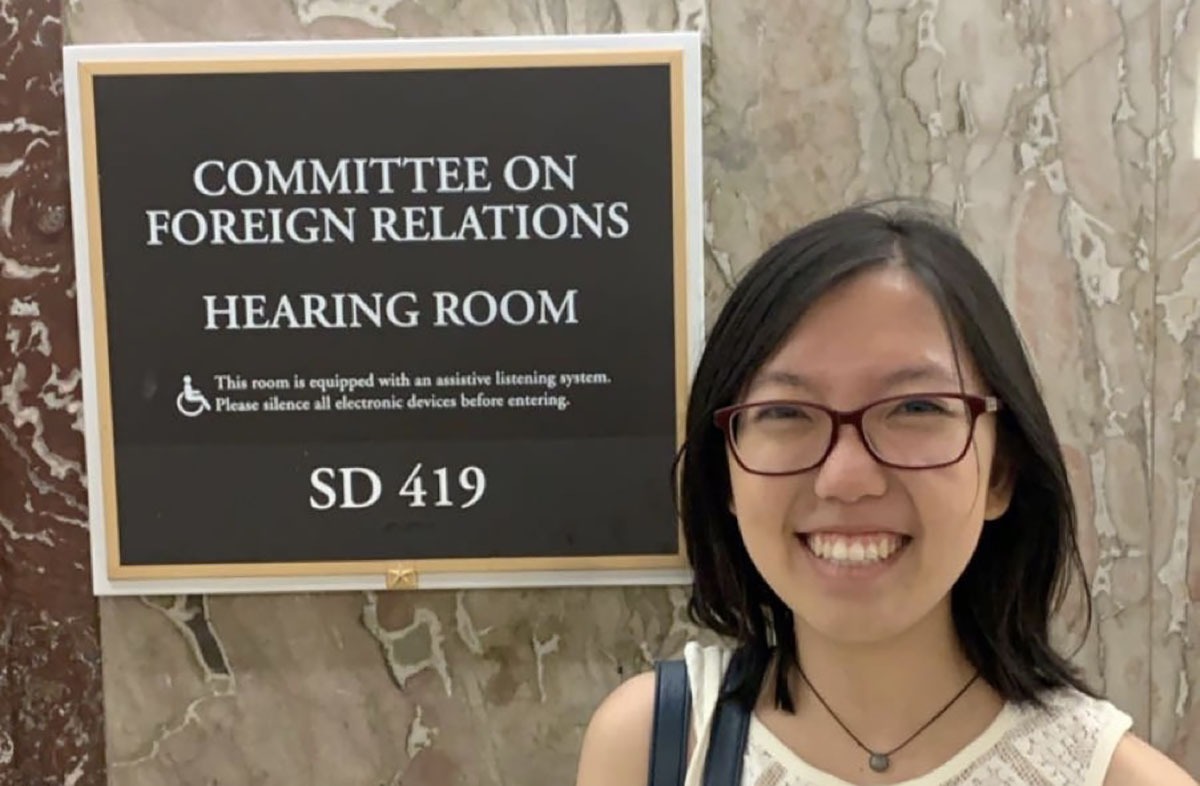
Policymaking by Empathy: Interning at the State Department
By June Lee, ’21
It’s 8:10am when I walk into the office, my blouse lightly dampened by my walk under the merciless Washington, D.C. sun. As I head to my cubicle, I hear snatches of conversations on the humanitarian crisis in Yemen and the current status of peacekeeping in Mali. I can’t help but feel a secret thrill to be working alongside individuals on issues I’d only ever read about and studied in classes.
Interning at the U.S. State Department’s Bureau of Conflict Stabilization Operations was, academically, one of the most enriching experiences I’ve had. Through weekly meetings, I gained exposure to the incredible breadth of concerns incorporated into the United States’ conflict stabilization efforts, from the role of women in peace processes, to the importance of intra-group cohesion in negotiations, to the efficacy of interventions by nonprofits and other third parties. No matter what project I was working on, it was fascinating to realize that here, my efforts could have a direct application for policy. Translating an article evaluating violence reduction in Colombia could directly inform the bureau’s engagement with partner organizations on the ground. Similarly, developing a digital framework on Excel depicting election violence indicators could help the bureau allocate funding and resources quickly to mitigate the risks of political violence. Over time, I also gained familiarity with the inter-agency process and overlapping departmental structures responsible for developing and implementing U.S. foreign policy.
Yet the most valuable thing I learned from my internship was the incredible depth of empathy it takes to work as a public servant in the State Department. The individuals I encountered worked on projects that directly affected the welfare of communities in countries emerging from conflict, and they were constantly thinking about the communities they were seeking to support. This mindset translated to all aspects of their work. My main supervisor related how, while serving as a foreign service officer in New Delhi, he would often bike to work with a camera, and offer to take pictures of people on the street. Their surprise and joy upon receiving a picture of themselves led to his receiving a flurry of texts and blessings every holiday. Another director, frustrated with the United States’ failure to address the humanitarian crisis in Syria, was motivated to resign and work for a nonprofit focused on human rights advocacy for Syrians and other refugees. And, during my daily commute, another officer explained how he had worked in Afghanistan for 18 years, an experience he spoke of with a hint of sadness but also admiration for the resilience of the Afghan people.
Since my internship, I’ve been determined to embrace this mindset. As a director of Stanford in Government and a peer advisor in international relations, I’ve sought to encourage more students to pursue careers in policy and public service. And, while working on my senior thesis, I am committed to developing a research paper that can be beneficial to policymakers and useful in advancing the United States’ efforts in conflict resolution.

Originally from Sunnyvale, CA, June Lee, ’21, studies international relations at Stanford. In addition to completing a Cardinal Quarter summer fellowship with the State Department’s Bureau of Conflict Stabilization Operations in the summer of 2019, June serves as the director of diversity and outreach of Stanford in Government and as a peer advisor for the international relations department. June is also an incoming honors student with the Freeman Spogli Institute’s Center for International Security and Cooperation.

Girls Run the World in Gorongosa National Park
By Eric Wilburn, MS ’18, MA ’18
Gabriela “Gaby” Curtiz grew up just down the road from Gorongosa National Park in Mozambique. The park is one of the most biodiverse places on Earth and is surrounded by more than 200,000 people who live on very limited resources. These neighboring communities struggle to make ends meet due to lack of employment. Many young women in these communities lack the opportunity to finish primary school because of societal expectations, household responsibilities, and a shortage of schools and teachers.

When Gaby was twelve years old, her primary school showed a National Geographic film about Gorongosa National Park, sparking her dream to work with animals in the park. Nine years later, Gaby was certified as the first female safari tourism guide in Gorongosa’s history.
I met Gaby last year on her first trip to the United States. She was visiting Boise State University, where she will begin her undergraduate studies this fall. Of course, service was a part of her trip! She gave a talk to a group of elementary school students about Gorongosa. It was amazing to see their eyes light up and their hands skyrocket to the ceiling with questions about her life in Gorongosa. She emphasized the importance of working with local communities in conservation efforts, and explained that providing livelihoods for local families was the key to sustainable nature conservation. Her example? Coffee.
Why coffee? Because there are hundreds of families like Gaby’s living on the flanks of Mount Gorongosa that need an alternative to unsustainable agricultural practices to feed their families. There is no need for farmers to cut down the forests to make room for non-native crops, as farmers can plant native hardwood saplings in between the rows of coffee to provide shade. Coffee gives these farmers a dependable income while helping restore the rainforests of Gorongosa.
I was thrilled to hear Gaby share her story, and was particularly excited when she chose coffee as her example. Having recently graduated from Stanford, I had just begun working with Gorongosa National Park to launch Gorongosa Coffee, a for-profit company that sells premium roasted coffee around the world and sends 100% of profits back to the park to support operating costs.
After her talk, Gaby and I were chatting about how Gorongosa Coffee wanted each of our roasted coffees to support a different initiative in the park. Gaby said that the most unique aspect of Gorongosa is that the park fundamentally believes that girls’ education is the key to both human development and nature conservation.
Inspired by Gaby, Gorongosa Coffee created a Girls Run the World coffee that sends 100% of profits to help over 20,000 girls in Gorongosa finish high school. The funds help build schools, provide high school scholarships, and connect girls with mentors through afterschool programs. We hope to demonstrate that when we give girls in Mozambique the confidence, capability, and opportunities to determine their own futures, we encourage more leaders like Gaby.
One of the defining aspects of our model that helps ensure our company has a positive impact is that the lone shareholder of Gorongosa Coffee is the trust that funds the park. In other words, Gorongosa Coffee is a social enterprise which keeps control of this community-based initiative within the community it serves.
Gaby graduated from high school in Gorongosa and will start at Boise State University in September, pursuing a degree in business tourism. Her goal is eventually to become the head of tourism for Gorongosa National Park.
Gaby and I come from very different backgrounds, but we share a commitment to serving the people, wildlife, and ecosystems of Gorongosa. We believe that the path forward for people and the planet is that every business thrives, not to fill the pockets of a few shareholders, but in service of an equitable and sustainable future for all.
I invite you to help us empower young women like Gaby from the communities of Gorongosa to break barriers and bring positive change to their communities. You may order our coffee at GorongosaCoffee.com.

Eric Wilburn, MS ’18, MA ’18, served in the Peace Corps in Mozambique before arriving at Stanford to pursue dual masters degrees in environmental engineering and public policy. During his time at Stanford, Eric was a Graduate Public Service Fellow and also coached the Stanford Triathlon Team. Recently, Eric has been helping to launch a company called Gorongosa Coffee that aims to benefit local communities, wildlife, and nature in Mozambique by supporting conservation, education, and economic development.
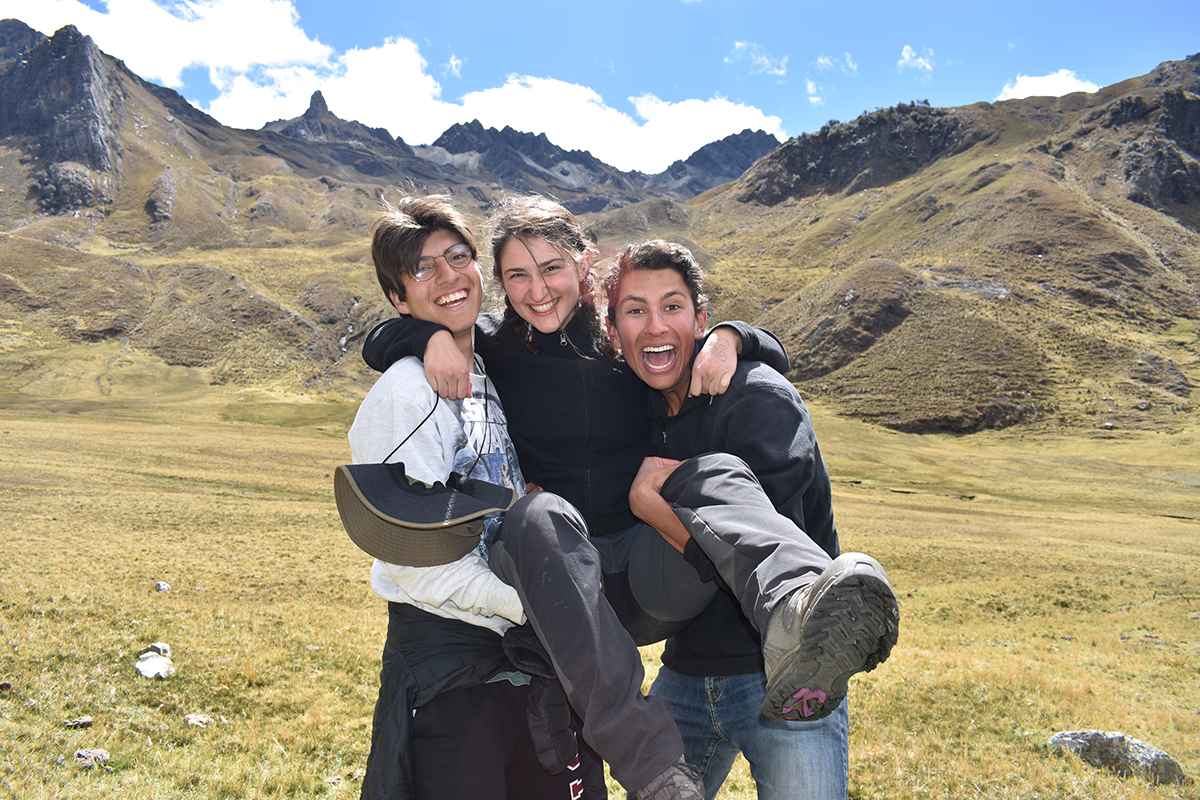
Global Engagement: Engineering Solutions for Sustainability
By Adam Nayak, ’22
Ever since I was little, I have been fascinated with water. I grew up four blocks from Johnson Creek, a local stream in southeast Portland, Oregon. My mom took me down to the park to play in the water, letting the currents wrap around my legs as I searched for tadpoles and capered with dragonflies.
Each month, my family would wake up early in the morning to work with our local watershed council, removing invasive species, planting native species, and picking up trash around the stream.
It was here that my younger sister and I learned about the great salmon migration. I remember being fascinated with the fish: their perseverance, determination, and tenacity, traversing upstream to their birthplace to continue their lineage. As a boy, I was always searching for salmon, but as an urban stream, Johnson Creek faced serious water-quality challenges due to a history of pollution, and I was never able to find any fish.
As I grew older, I developed an interest in the science behind water treatment and ecological systems, looking for solutions to problems of contaminated stormwater and habitat loss. Volunteering with the Johnson Creek Watershed Council was one of my most rewarding experiences, instilling in me a value for public service and community engagement that has grown with me at Stanford.
Through my involvement in Engineers for a Sustainable World (ESW), a Cardinal Commitment student organization, I have been able to pair my interest in environmental conservation with engineering practice. In particular, I worked on a small team of students during a two-quarter Cardinal Course to design and prototype sustainable infrastructure solutions in Chavín de Huántar, Perú, an archaeological site in the Andes Mountains. Through the Cardinal Quarter program, I traveled to Perú with my team this past summer to implement the project and promote cultural conservation.
Our green roofs and modular tensile structures were designed as a new approach to flood mitigation in a rural setting, with a focus on aesthetic integration of roofing structures at a culturally significant site. This opportunity not only strengthened my Spanish language and communication skills, it allowed me to collaborate with engineers and community members, as well as to learn about engineering practices in the context of a different culture and setting.
Service is powerful to me because it establishes a sense of community and belonging. As a student who is passionate about equity and inclusion, I hope to work on sustainability projects in diverse communities worldwide. The experience in Perú has enhanced my ability to collaborate on a team that spans cultural backgrounds and has reaffirmed my passion for public service projects.
Now as a sophomore, I co-lead international ESW projects focused on sustainable engineering and equitable development. They have brought me back to the theme of water, leading a project with community partners in Ghana focused on organic waste mitigation and water treatment through biochar production for carbon filtration.
For me, service involves building relationships and working collaboratively, whether internationally with an organization like el Ministerio del Cultura de Perú, or locally with the Johnson Creek Watershed Council. Both experiences involved a long-term commitment to addressing community needs. From these experiences, I have come to focus on promoting equitable access to resources for all communities, regardless of background. Looking forward, I hope to continue my work in sustainable development as an environmental engineer, focusing on clean water and equity practices in the public sector.

Adam Nayak, ’22, studies civil and environmental engineering. Originally from Portland, Oregon, Adam’s childhood interest in environmental sustainability has led him to pursue a Cardinal Quarter in Perú, enroll in Cardinal Courses, make a Cardinal Commitment with Engineers for a Sustainable World, and serve as a Cardinal Service peer advisor. Adam has also been involved in the Multiracial Identified Community at Stanford; Stanford Strategies for Ecology Education, Diversity, and Sustainability; Students for the Liberation of All People; and Students for a Sustainable Stanford.
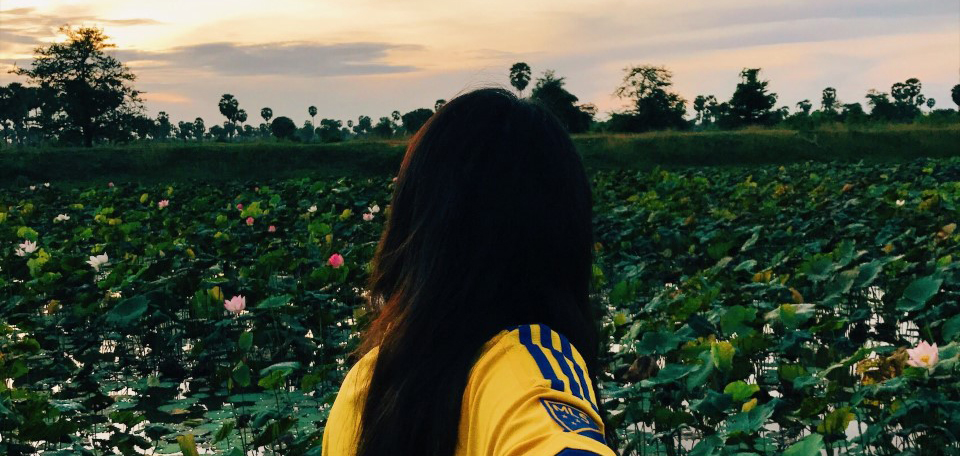
Learning Cultural Humility in Rural Cambodia
By Amy Kouch, BS ’19, MS ’20
“I would love to live here,” I said in awe, staring at the glorious sight before me.
I was working and living in a rural village in Cambodia. A friend from the village and I were sitting in an endless grassy field, having just finished soccer, a slight breeze cooling off the sweat dripping down our faces. The sun was beginning to set over the lotus ponds, the sky erupting in warmth, kissing the pinks of the petals and contrasting the deep greens of the leaves. There was something so peaceful about resting here with room to think and to spend evenings talking to someone who grew up on the opposite side of the world. I was away from the busyness, experiencing something so simple and so beautiful.
My friend turned toward me with a curious expression on his face.
“If you lived here, you would be spending hours working in the fields, not watching the sun set.”
I was taken aback by this truth. Suddenly, I was aware of how easy it can for outsiders in this community to romanticize a life of simplicity, to be drawn to place like rural Cambodia with good intentions to make an impact.
In the summer of 2017, I interned with Sarus, a nonprofit organization that focuses on peace-building for students from countries with a history of conflict.
There were every day hardships and issues that persisted for those who lived there, such as the absence of resources for education, the lack of running water, of reliable electricity—aspects that I took for granted living in a developed and industrialized economy. I also realized that these were the problems I wanted to help solve.
But I was an American visitor, an outsider in this community. In one month, I would return home. I took this moment to assess what more I could do.
What did this community need? How can I go beyond my internship and create real change and address issues that the community cares for? What does it mean to practice ethical and effective service throughout a lifetime?

Amy Kouch is a coterminal master’s student in Civil and Environmental Engineering with a bachelor’s in human biology. In summer 2017, she interned with Sarus through the Community Arts Fellowship. She was a member of the Public Service Honor Society, a year-long cohort of that provides seniors the opportunity to reflect on their public service and develop their civic leadership identities. She also interned at the Office of Sustainability and was a member of the Stanford Khmer Association and Sigma Psi Zeta sorority. She is from Rohnert Park, CA.
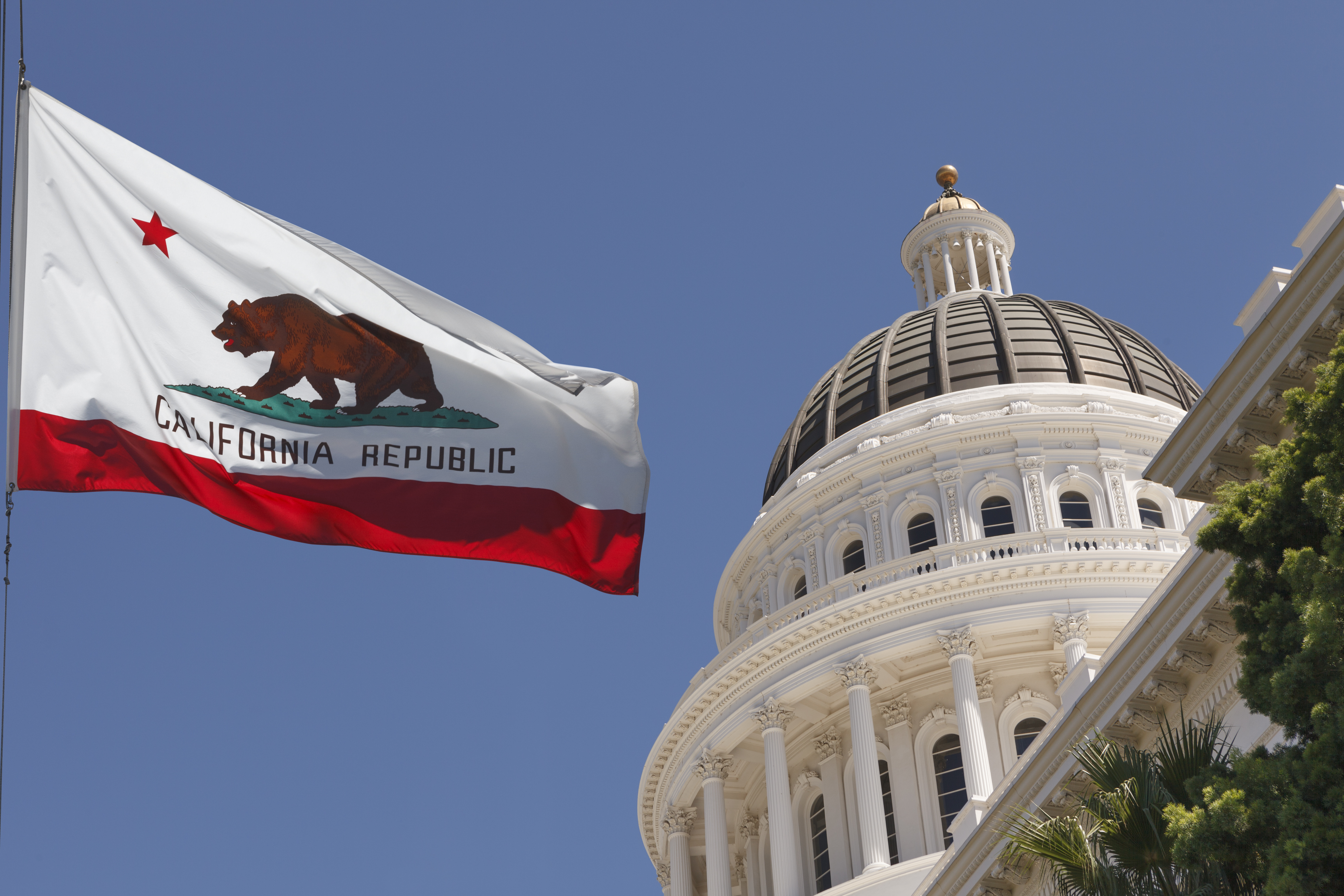
The Global and Local Conversations About Agricultural Conservation
By Kyle Van Rensselaer, ’19, MA ’20
What happens when you pave over a garden? The consequences are fairly small. How about when unchecked urban development paves over tracts of fertile agricultural land?

In a state like California, a major breadbasket for the United States, such changes can threaten food security, land conservation, and farmer welfare. These are pressing issues that the California Department of Conservation’s Division of Land Resource Protection (DLRP) is aware of, and that I was able to help tackle during my Cardinal Quarter in summer 2018.
During my time as a fellow, one of my major assignments was a research project looking into unique agricultural policies in other countries, namely the Netherlands and Israel. My research contributed to a longer white paper that was presented at a UC Davis symposium on climate change in September 2018, which was itself affiliated with the well-known Global Climate Action Summit in San Francisco.
The white paper discussed Californian agriculture broadly and paid particular attention to agricultural conservation in the face of climate change. The Netherlands and Israel, as I discovered through my research, are notable because they prioritize agricultural productivity and sustainability in their legal and economic structures, albeit in much different ways.
Despite having a high population density, the Netherlands has an incredibly efficient agricultural sector that invests in innovative practices such as urban rooftop gardens, large-scale greenhouses, and public engagement with sustainable farming. Israel, on the other hand, caught our attention because 93 percent of its agricultural lands are owned and leased out by the central government, creating an interesting dynamic between free-market impulses and traditional conceptions of how national land should be used.

Although reading about these international programs was fascinating in itself, my team and I were most interested in how the policy prescriptions in the Netherlands and Israel could be applied to California law.
In particular, DLRP is interested in expanding and improving its conservation easement program. This program is designed to promote agricultural conservation by bringing farm owners, land trusts, and the California state government together to protect private farmland from development into perpetuity. I was lucky to visit some of the farms that have signed conservation easement contracts and are therefore committed to conservation efforts on their own properties. These visits were a great learning experience because I was able to see how the Department of Conservation builds dialogue with key stakeholders: the farmers who keep California’s agriculture sector alive and running.
The partnership between DLRP and private landowners gave me insights about community engagement and cultivation. Despite political divides, the government and its stakeholders can find common ground and achieve mutually beneficial outcomes.
In particular, many farmers in California support the Republican Party and, as such, tend to be more skeptical of the environmental policies that lawmakers in Sacramento actively pursue. However, DLRP’s conservation easement program has generated buy-in among these farmers because all parties agree on the relevance of supporting agriculture in the long-term.
My research project seemed more relevant when considered alongside these takeaways from the field: while public ownership of farmland, as in Israel, would be a hard sell in the United States, the targeted investments into agricultural sustainability such as those that the Netherlands makes are much more palatable for farmers in the Californian Central Valley. Witnessing DLRP’s role as mediator between lofty policy goals and actual hands-on implementation of farmland conservation was an opportunity to see how the government can bring together diverse stakeholders, and even unusual allies, to preserve a way of life for generations.
Kyle Van Rensselaer, ’19, MA ’20, is an international relations major, chemistry minor, and coterminal student in international policy. He is the historian for the chemistry fraternity Alpha Chi Sigma, head writer for Stanford Chaparral Magazine, a peer chemistry tutor for the Vice Provost for Teaching and Learning, and a member of the Stanford Axe Committee. He is from Auburn, CA.
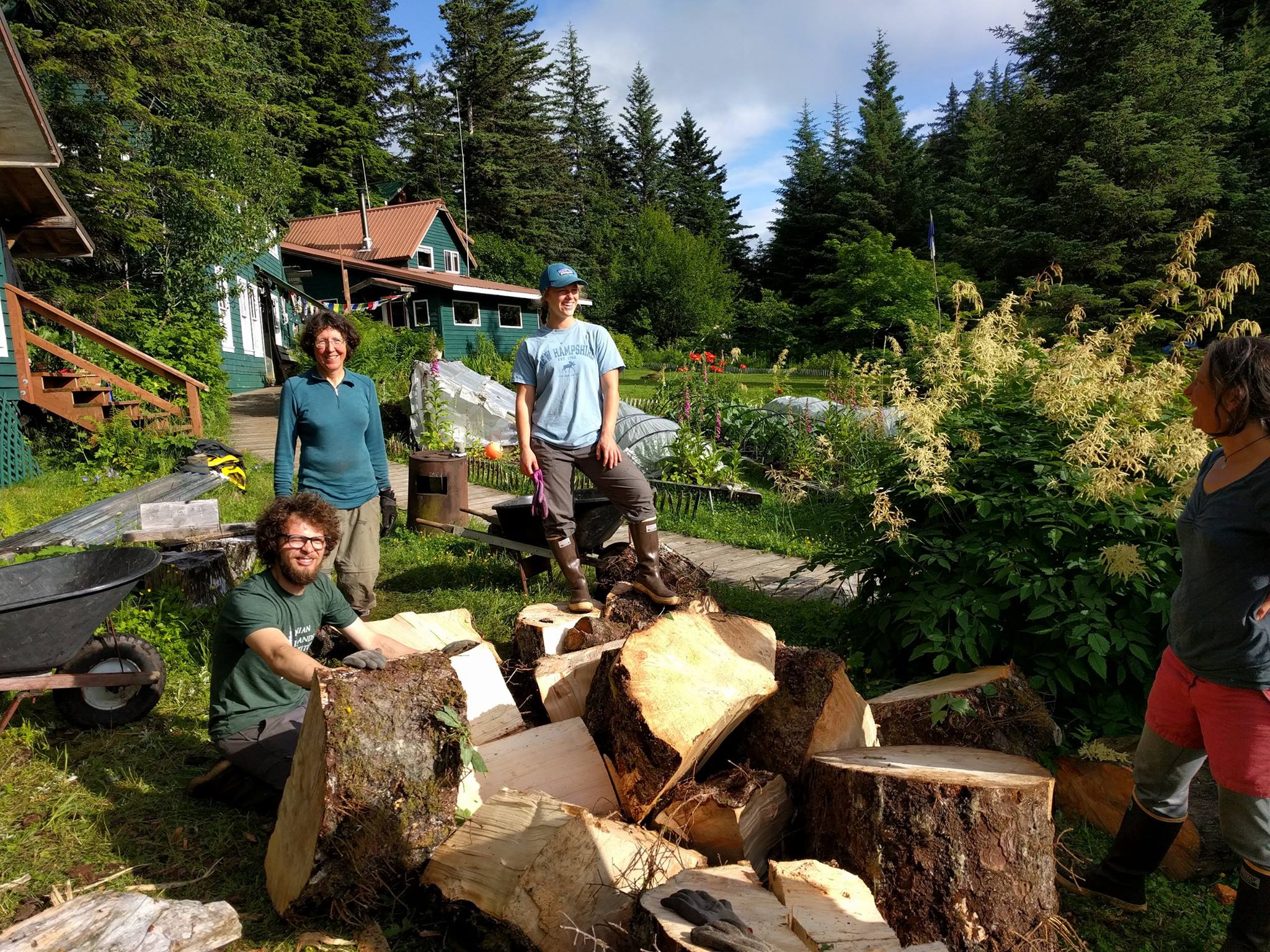
Notes from Magic Beach: small-town sustainability in southeast Alaska
By Madelyn Boslough, ’18 (Electrical Engineering)
Sea lions sang me to sleep in the dusky pink afterglow of a midnight sunset in southeast Alaska. Their bellows, echoing across the strait to my tent on Magic Beach, were surprisingly soothing, harmonizing with the gentle crash of tiny waves on gravel and kelp. The beach was aptly named. Each morning, I woke under a low ceiling of fog, obscuring the peaks of the Inian Islands and giving the whole place a mystical air.
Though I was born and raised in Alaska’s Wrangell St. Elias National Park, I had never spent time in the Southeast region of the state until I was awarded a Cardinal Quarter through the Alexander Tung Memorial Fellowship to serve with the Inian Islands Institute.
I was captivated by the beauty of the Institute’s location on a remote rainforest island off the coast of Gustavus, Alaska, and intrigued by its mission of inspiring youth to care about the environment by using experiential education. The Institute was founded by four Stanford PhD students, including the director, Zachary Brown, a recent PhD graduate in environmental science and fellow Alaskan.
The school intends to model sustainable living, and Zach offered me a position updating the Institute’s micro-hydroelectric system, which provided electricity to off-grid property. I was thrilled to take the lead on a project in small-scale renewable energy. I love Alaska with all my heart and have always intended to use my education to serve the environment and communities that shaped and supported me. I majored in electrical engineering to work in renewable energy and influence my state to rely less on oil and use more environmentally friendly technologies.
Over the course of the summer, I researched existing micro-hydroelectric systems in rural Alaska and began to plan a retrofit of the system on the island. I assessed the school’s present and future electricity demands, and the potential for incorporating other renewable energy sources like wind and tidal.
I was grateful for training in Stanford’s Principles of Ethical and Effective Service, especially preparation and humility. Preparation guided me through the tasks and challenges I expected; humility allowed me to navigate the inevitable unexpected tasks and challenges for which I had not prepared.
For example, on my first trip to the island where the Institute is based, I discovered that I would be closely working with a seasoned fisherman named Greg. Greg was a brilliant engineer without a college degree, who imagined, designed, and installed the micro-hydroelectric system on the island in the 1980s, long before terms like “renewables” and “microgrids” were heard in Alaska. He had done all this by corresponding with a Canadian hydroelectric manufacturer via handwritten letter, and with the help of a few good friends for the system’s actual construction.
Then, nearly 40 years of dependable renewable electricity later, I showed up to “fix” his ingenious but aging design. It took weeks for Greg to stop responding to my questions with a terse, “You’re the electrical engineer; you tell me.” Only by persistent, respectful questioning and listening was I able to earn his grudging willingness to help me.
Living in Gustavus was a profound civic awakening. An isolated town of only 400 people, Gustavus is an intimate place where everyone knows everyone, and every person plays a visible role in the social fabric. Just by arriving, I took on a role as well. My actions could affect everyone in town, and realizing this, everything I did took on a greater importance. I had a responsibility to the community of Gustavus, and by the end of the summer, I had made an impact. I left knowing that my actions make a difference and that I can be of real service to the Alaskan communities I love.
Working on small-scale renewable energy was a microcosm for the greater issues of climate change and planetary sustainability—a window into a wicked problem. Working with Zach, Greg, various handymen and community volunteers, and the Institute’s board of directors pushed me to understand how to work with a team with diverse expertise to tackle difficult problems. Through my fellowship I focused on the questions of what I want to do with my life and what kind of impact I hope to have on this world. I learned from Zach that a bias toward action is key—in the face of a terrifying, massive problem like climate change, the only thing to do is to choose somewhere to start, and do something.
Madelyn was one of 486 students who completed a Cardinal Quarter in 2017.
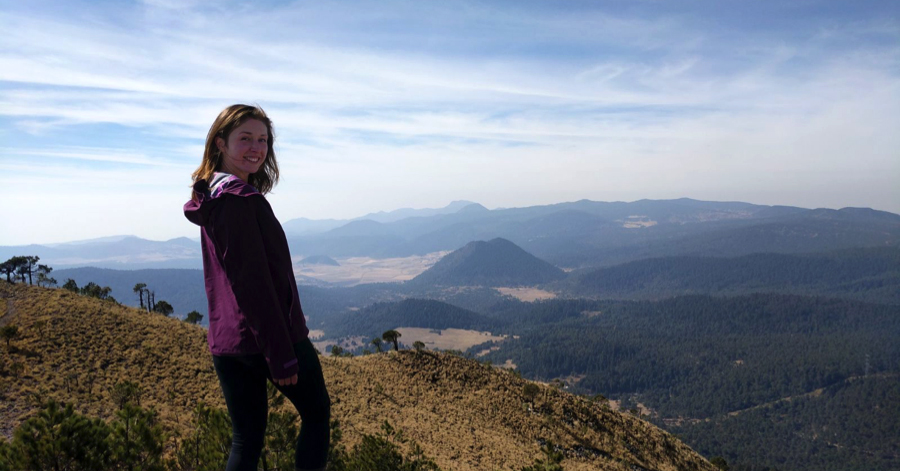
Building cultural sensitivity in conservation

Maria Doerr, ’17 (Environmental Systems Engineering)
When the rain starts, we’re not ready. Ten of us stand in the truck bed, grasping the railing as the vehicle lurches down the muddy trail. “¡Aquí!” our community partner Sapo (“toad” in English) yells, grinning while he pulls up a dusty plastic tarp from below our feet. We stretch it over our already-soaked heads as the truck continues weaving through the forest.
Since September, I’ve been working as the Water & Cities Fellow with Conservation International Mexico, supporting an initiative to protect the watersheds of Mexico City.
Mexico City’s water issues are complex. When it rains, parts of the city flood. Every day, approximately 1,000 people settle in the city, creating an ever-growing thirst to quench with an ever-dwindling water supply. The aquifers that provide 70% of the water to 23 million people in the megalopolis are greatly over-exploited. Uncontrolled urban expansion, poor land management, and pesticide-use in the watersheds that recharge these aquifers complicate the situation all the more.
Conservation International works to curb these impacts in part by creating a common dialogue among players in city, rural, and natural landscapes. For me, this has meant sometimes pulling on my boots and heading to the mountains at 5:00 am. Other times it’s meant drinking coffee with corporate sponsors in business casual.

The challenges of uncontrolled urban growth, poor land management, and pesticide-ridden farming are complicated. Development isn’t just bad; planting trees isn’t just good. When working in rural zones the goal is not to tell indigenous community members how they should envision their towns, but rather provide them with the resources and technical experience to do so as thoughtfully as possible and with natural systems in mind. Similarly, when talking with urban residents and sponsors who think that the hills should be covered with trees, we explain that the ecosystems of the watersheds are more complex than this and include native grasslands that also need to be protected, sans trees. Learning to synthesize these intricacies in our communications with colleagues and partners and in the implementation of our regional programs has been one focal point of my work this year.
Since graduating, I’ve been challenged to put my principles into practice and test out frames for ethical and effective service. Questions I posed in class, I now ask on a day-to-day basis: How can I best support community-driven environmental work in Mexico as an American? What ways can I build cultural sensitivity in how I approach conservation? Where does my voice belong and how can I uplift the voices of others?
Work trips like the one with Sapo remind me that while the mountains are indeed key to water security in the region, they are also a physical embodiment of Mexican cultural heritage. They are bigger than the articles I write, the excel sheets I analyze, or the meetings I attend. This land is home to nearly 100 indigenous communities, whose members include those with me in the truck bed. Through their experiences, I am all the more certain that the region’s future does not exist without the deep integration of traditional knowledge.
Living history fills the watershed, and at each turn, continues to teach me.
Maria is the 2017 Halper International Public Service Fellow with Conservation International. Learn more by reading her personal blog and listening to “Protecting People and Water in Mexico City,” a Making Contact radio piece she created in May, 2018.

Chemistry with Kusuma
By Elizabeth Wallace, ’18 (English, French Literature)
The last place I expected to use my evolving knowledge of organic chemistry was at an orphanage in rural India. Yet there I was, cross-legged on the floor of the Aarti Home dining hall trying to recall the difference between an alkene and an alkyne with a young woman named Kusuma.
“Akka, sister, it goes like this,” she tells me, bending over to draw the reaction arrows on my paper.
Kusuma was in her first organic chemistry class, but her dream is to go on to get her PhD. Her spunk and spirit inspire me. She is witty, sharp, and not afraid to speak her mind.
Every girl I met at the Aarti Home in Kadapa, India, was as dedicated and determined as Kusuma. Aarti Home was set up in 1992 by the incredible vision of Sandhya Puchalapalli, who determined that girls in her community should have a safe place to live and be educated, even if their families could not afford to provide it.
I came to Aarti in the summer of 2017, a Stanford intern eager to learn more about the organization and help in anyway I could. What I found was a center of female empowerment, a cradle of love and support where brilliant and strong women are molded. Aarti gave me hope that the future is undoubtedly female and because of that, indisputably bright.
Elizabeth is part of the 2017-18 cohort of the Public Service Honor Society, a leadership program for seniors run by the Haas Center.
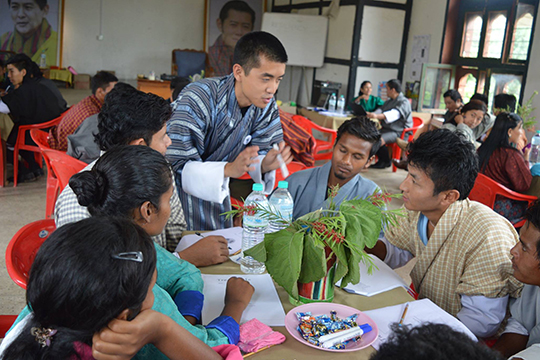
Investing in Bhutan’s youth
By Tim Huang, ’14 (B.A. Human Biology; M.A. Education)
I was drawn to the Himalayan Kingdom of Bhutan because of my interest in how the young democracy in transition was thinking differently about sustainable development and the well-being of its people. Thanks to a Haas summer fellowship, I spent two consecutive summers in college implementing a youth employment project with a local nonprofit, the Bhutan Youth Development Fund. After graduating from Stanford, I returned to Bhutan through the Omidyar Network International Public Service Fellowship, one of the Haas Center’s postgraduate fellowships. During my fellowship year, I worked to strengthen educational equity as a researcher for the Royal Academy, His Majesty the King’s Secretariat. I have since served as a Program Officer at the Bhutan Youth Development Fund, organizing child protection and youth empowerment programs with partners like UNICEF. Over the last 3 years, working in Bhutan has reinforced my belief that investing in the promise of our children and youth creates a more just and sustainable world.
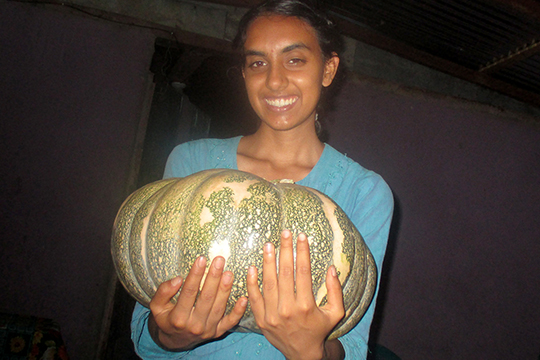
Caring for what we have
By Sneha Ayyagari, ’17 (Environmental Systems Engineering); MS ’19 (Civil and Environmental Engineering: Sustainable Design and Construction)
“Development is when people grow their conscience.” That is how a war veteran, skilled farmer, and environmental educator described to me what it means to create sustainable development. He explained that it doesn’t matter how much people do or don’t have; what matters is that they care for and care about what they have.
As a Schneider Sustainable Energy fellow in 2015, I worked with Asofenix, a grassroots organization that works to develop and improve the lives of rural Nicaraguans in the villages in the hilly state of Boaco. Throughout my fellowship, I supported projects that improved quality of life such as installing renewable energy, potable water infrastructure, irrigation systems, and clean cookstoves; creating an environmental education program; and supporting sustainable agriculture in the community where I worked and lived. I saw how the technical and educational parts of energy projects fit together into an integrated and transformational program. I was deeply moved by the opportunity to learn the stories of the resilient and loving people I worked with.
I also enjoyed learning the nuances of Nicaraguan culture, and the people I worked with became part of my family. I continue to call them every week. This fellowship reinforced my desire to couple my technical skills and interest in environmental engineering with my passion for teaching to create a more just and sustainable world.
Schneider Fellows work at leading U.S. nongovernmental organizations (NGOs) to tackle today’s sustainable energy challenges.
